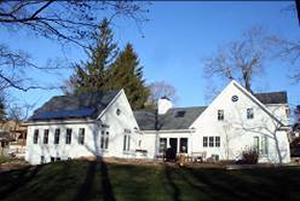
October 30th is National Weatherization Day. Home weatherization or weatherproofing is the practice of protecting a building and its interior from the elements, particularly from sunlight, precipitation, and wind, and of modifying a home to reduce energy consumption and optimize home energy efficiency.
Did you know that the typical U.S. family spends more than $1,600 a year on home utility bills? Unfortunately, a large portion of that energy is wasted. And electricity generated by fossil fuels for a single home puts more carbon dioxide into the air than two average cars. The good news is there is a lot you can do to save energy and money at home.
Whole House Approach
The key to achieving these energy savings in your home is a whole-house energy efficiency plan. To take a whole-house approach, view your home as an energy system with interdependent parts. For example, your heating system is not just a furnace — it's a heat-delivery system that starts at the furnace and delivers heat throughout your home using a network of ducts. Even a top-of-the-line, energy-efficient furnace will burn a lot of fuel if the ducts, walls, attic, windows, and doors are not insulated and/or leak. Taking a whole-house approach to saving energy ensures that dollars you invest to save energy are spent wisely.
Energy-efficient home improvements not only make your home more comfortable, they can yield long-term financial rewards. Reduced utility bills more than make up for the higher price of energy-efficient appliances and home improvements over their lifetimes. In addition, your home could bring in a higher resale price when you sell. The easy, practical solutions for saving energy include tips you can use today, throughout your home — from the roof, walls, and insulation that enclose it to the appliances and lights inside.
How to Start Saving Energy and Money Today
- Get heating system serviced. A typical home, 43% of the utility bill goes toward heating and cooling, according to the U.S. Department of Energy.
- Install a programmable thermostat that pays for itself in less than the first year.
- Bundle up your heater. Insulating hot water tank blankets only cost about $20 and they can save you 10% on your hot water bill this winter.
- Lower the thermostat on your hot water heater to 120° F.
- Add more insulation to your attic. About 40% of the energy that a single family house consumes goes toward heating and cooling.
- Seal air leaks.
- Replace windows and doors.
Sources of Air Leaks in Your Home
Air infiltrates into and out of your home through every hole, nook, and cranny. About one-third of this air infiltrates through openings in your ceilings, walls, and floors. One of the quickest dollar-saving tasks you can do is caulk, seal, and weatherstrip all seams, cracks, and openings to the outside. You can save as much as 10% on your heating and cooling bill by reducing the air leaks in your home.
Air often leaks through a dropped ceiling, Recessed light, Attic entrance, Sill plates, Water and furnace flues, All ducts, Door frames, Chimney flashing, Window frames, Electrical outlets and switches and Plumbing and utility accesses.
The Green Home
For your overall home improvement, you can save money, improve your family’s health, and save the planet. When in doubt, have an energy audit done or educate yourself on the whole house approach.
Given variations in energy consumption and house size, results will naturally vary. The data used is based on comprehensive local and national research and a combination of reports from the U.S. Department of Energy, Environmental Protection Agency, ENERGY STAR® for Homes Program, US Green Building Council’s LEED for Homes Program, American Council for an Energy-Efficient Economy (ACEEE), and information directly from university studies and homeowners with actual performance feedback.

